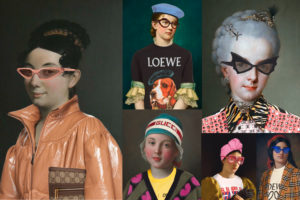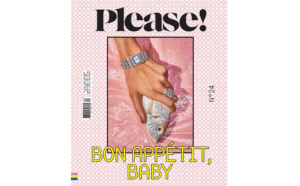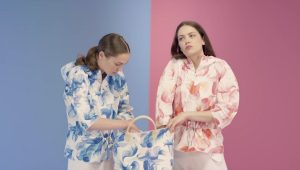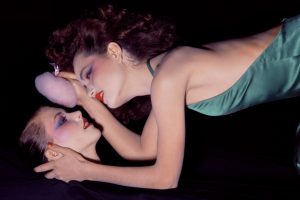Who are the people you choose to paint portraits of ?
Friends and people I care about.
Can you tell us more about your painting process ?
I take photos to work from, with an idea in mind, and I position and light my subjects. Sometimes I tweak the composition in Photoshop and place my sitters in a context or in front of a completely different landscape or background. For my show at Almine Rech (in Paris in September 2017), I actually used the cartoon landscape from Laughing Cow (Vache Qui Rit) packaging for the milkmaid portraits.
I love the titles you give your portraits. How do you find them ?
I am constantly creating an ongoing poem of found, overhead or misheard phrases. I string them together into a stream of consciousness poem that sometimes rears its head in my video work, and sometimes I use fragments for titles. Other times I just look back through my texts with the person I am painting and use something they’ve said. I like there to be this fictive, almost arbitrary narrative that the viewer can attribute to the painting. There can be this nonsensical or humorous quality through the unlikely pairing of image and title.
Your first solo exhibition in Paris focused on dairy products. Why pick such a theme ?
I was looking at instances of dairyrelated imagery throughout art history, such as the Vermeer Milkmaid, and how this fictive narrative surrounding milk has formed through advertising and media. Images such as this wholesome Vermeer or the more contemporary porny buxom milkmaid tend to portray the consumption of milk as wholesome and natural, parallel to enjoying blondes, cleavage and mountains. I was comparing that to the contemporary Western fear of dairy, or lactose intolerance, and rising popularity of nondairy alternatives such as almond milk and soy milk. We are faced with both ‘truths’: dairy is wholesome and part of a balanced breakfast, and simultaneously, dairy is abject and gross (I mean really, why do we consume another animal’s growth liquid ?). I created works looking at how both of these simultaneous ideas are signified through imagery, and using that same imagery, I created these works, through painting, sculpture and video, that presented a confusing synthesis of these recognizable symbols, with a more abject and less clear-cut message. Using the same imagery that typically advertises dairy products, I had ‘milkmaids’ toting Ranch dressing, Lactaid, and Almond Breeze. And then, using the same Dutch golden ageinspired cornucopia still life trope, I created sculptural works where milk (made of plastic) ran through real cowhide, reminding the viewer of the abject nature of milk consumption.
I read that Marx influenced your art. How so ?
In one series of sculptural work I created a few years ago, the bread bags and the sex swings made of leather with Chanel or Dior logos, I was thinking about Marx’s theory of commodity fetishism, both literally – in the sense that I created commodities that had fetishistic accoutrements, and also philosophically. Commodity fetishism concerns itself with how the mundane consumer product gains a mysticism and desirability based on aura, not on physical material or hours of labor. Designer bags and artworks both are items of great monetary value, but not because of the material or hours of work that went into them, rather their value is derived from aura, which comes about in a number of ways. My work explores, celebrates and critiques the making of this ‘aura’, how identity and aura are commodified by advertising and economics, how desire can be cultivated for objects based on a number of external factors. I think about advertising, how sexuality is tapped in such overt ways in order to create desire, and I use some of those same strategies in my work. The way a model will be posed, or the glimmer of dripping cheese in a sculpture, all tap into the makings of desire.
You’ve painted a lot of food in your pictures: a ripe-looking fig, a papaya, even a can of La Croix. How do you choose the associations between the person posing and the food they hold ?
I don’t even know anymore. Fruit and vegetables and the genre of the still life have been the subject of paintings since the beginning of time, I’m not reinventing the (cheese) wheel here. These are formally beautiful organic shapes that are very enjoyable to paint or sculpt. Inherently in our society we oversexualize everything, so we tend to project gender associations onto inanimate objects or fruit. Hard not to see a banana or eggplant as phallic, and a peach or oyster as yonic. I’m critiquing the ridiculous binary way in which we have been trained to perceive these things, not only in order to critique our relationship to food as a (maledominated) society, but also to draw a comparison between the way we tend to use binaries to oversimplify things that are not so easily compartmentalized.
Does appetite come into the process ? Wanting to make people feel hungry, or the opposite – wanting to put them off the food you’re representing ?
No. I’m hungry right now though.
You’ve also done food installations. Do you use real food ?
No of course not !!! That would be gross and non archival. All of my food sculptures are handmade, I use silicone molds and cast the items out of urethane which I pigment and then handpaint with oil paint. It is painstaking and intense and heavy and looks super real in photos, but in real life you can tell it’s a sculpture. Alas, the problematics of only seeing artwork through jpgs…
Do you take pictures of your food on social media ?
It seems like people are doing it a bit less nowadays, or in a more ironic way maybe (ugly-looking food for example). Not really… unless I’m in France like I am right now and completely enamored by the beautiful produce. Can’t stop eating figs.
Your cat Pluto seems to have quite a healthy diet. Has he ever tried to eat one of your props or sculptures ?
Pluto is a fruit bat. He loves cantaloupe, persimmon, mango, watermelon… He’s an angel boy and he’s very curvy. He’s never eaten a sculpture because he’s a very smart boy and (unlike SOME PEOPLE) he can tell the difference between the edible and the sculptural… !
Chloé Wise’s next exhibition will be at Almine Rech Gallery London, April 2019.



